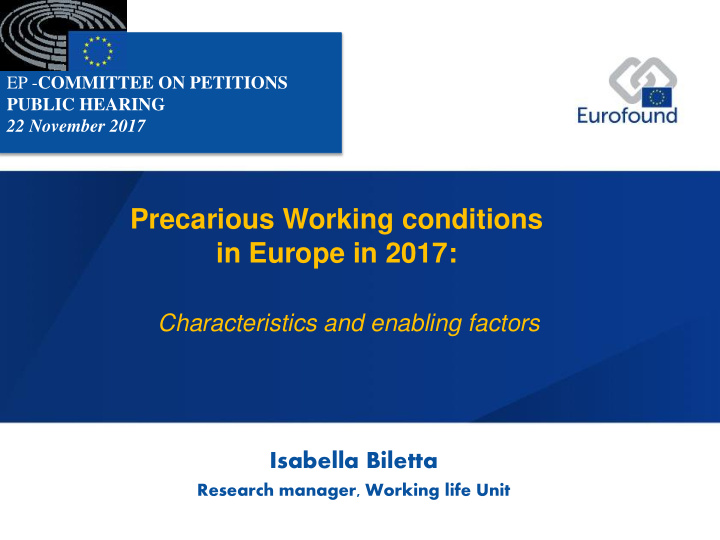



EP - COMMITTEE ON PETITIONS PUBLIC HEARING 22 November 2017 Precarious Working conditions in Europe in 2017: Characteristics and enabling factors Isabella Biletta Research manager, Working life Unit
Content • Precarious work characteristics – Multidimensional features – Precarity ‘ sprinkles ’ and ‘Job quality ’ • Enabling factors – Lack of clarity employment status – Transformation of sectors/companies/workplaces – Still room for improvement of WC • Key Challenges – Increasing transfer of risks to individuals – Devising a ‘collective interest ’ – Sens of « work » 2
• I Precarious work characteristics – Multidimensional features – Precarity ‘ sprinkles ’ and ‘Job quality ’
Job quality indices Social environment Physical environment • Adverse social behaviour • Social support • Posture-related • Management quality • Ambient • Biological and chemical Skills and discretion • Cognitive dimension inc.computer Work intensity use • Decision latitude • Organisational participation • Quantitative demands incl. emotional • Training • Pace determinants and interdependency Prospects Working time quality • Career prospects • Employment status • Job security • Duration • Downsizing • Atypical working time • Working time arrangements • Flexibility Earnings Source: Eurofound (2012), Trends in job quality in Europe, Publications Office of the European Union, Luxembourg. 4
Job quality profiles High flying Smooth running Active manual EU28 workforce 2015 Under pressure Poor quality 19% 22% 13% 25% 22% 5
Employment quality: dimensions of de-standardisation Beneficial employment conditions and relations Standard Stable, full-time employment, standard working times, a employment sustainable income and good employment relations Beneficial employment conditions and relations Portfolio Exception: long working hours, high working times employment irregularity and uncompensated exceptional working times Work for pay Stable, full-time employment, standard working times and a Instrumental employment sustainable income, but no additional rewards/training opportunities and poor employment relations Adverse employment conditions and relations Precarious unsustainable Specific: involuntary part-time employment and a low income employment Adverse employment conditions and relations Precarious intensive Specific: long working hours, schedule unpredictability and employment uncompensated exceptional working times Eurofound, 2014
Features of work intensity Hide Emotionally Working at Working to Enough time Handling Frequent Three pace emotions disturbing high speed tight deadlines to do job angry clients disruptive determinants (most of situations (3/4 +) (3/4+) (never/rarely) (3/4+) interruptions time/always) (3/4+) Managers 31 40 31 18 9 28 13 35 Professionals 28 37 29 21 15 23 12 36 Technicians 30 35 33 19 12 22 10 35 Clerks 32 34 34 19 9 18 9 28 Service workers 35 30 29 25 13 15 8 41 Agricultural workers 31 28 19 8 5 8 9 11 Craft workers 44 48 45 11 6 13 8 20 Plant operators 41 45 46 9 9 7 10 24 Elementary occupations 40 36 27 6 5 7 11 21 EU 28 34 37 33 17 11 17 10 31 Source: 6EWCS – EU 28 in 2015 7
Working time quality • Working hours continue to decline Duration • 26% no 11-hour break between working days Atypical • Increase in shift and Sunday work • Long working, very short working hours working hours • Companies set working time arrangements Working time • 13% notice of change 24 hour of less arrangements • 12% work at short notice few times a month • 26% easy to arrange to take an hour off work Flexibility • 22% work in free time to meet work demands Source: 6EWCS 2015 8
Social environment - Figure 53 of the report : asb by ocucpation Source: EWCS 2005, 2010 and 2015 , EU 28 but EU27 in 2005 9
• II Enabling factors – Lack of clarity employment status – Transformation of sectors/companies/workplaces – Still room for improvement of WC 10
Prospects • Lack of clarity Employment status • Self-employed report multiple identities • 17% might lose their job in next 6 months Job security • 38% report good career prospects Career prospects • 23% report downsizing, 20% new jobs Employment change Source: EWCS 2005, 2010 and 2015 , EU 28 but EU27 in 2005 11
Employment status not clear for individuals EWCS Eurofound 2016
Genuine self-employment: How to spot it? Checklist Three checks = genuinely (Self-employed without independent 56% of SEWoE employees) • More than one client No or just one criteria fulfilled = Economically dependent worker • Authority to 13% of SEWoE hire/dismiss staff • Authority to make Two checks = grey zone 30% of SEWoE strategic business decisions Source: 6EWCS
Member State approaches to regulation • Creating a ‘hybrid’ status AT / IT 1 • Defining ‘Economically ES/PT/SI/SK Dependent Workers’ 2 • Establishing criteria for identifying LV./DE/MT 3 bogus self-employment • Establishing criteria for differentiating BE/IE/PL/NO employees and self-employed 4 Eurofound 2017
Classification of self-employed workers Source: 6EWCS
EDW Working conditions Not working Lower mental well long hours being More problematic financial situation EDW EDW Employees SEWoE SE WE More flexibility in setting Work intensity Working hours Self employed or not Self employed? WC of EDW (Eurofound 2013)
• III/ Key Challenges – Increasing transfer of risks to individuals – Devising a ‘collective interest ’ – Sens of « work »
‘New’ forms of employment Self-employed Employees Employment relationship n Voucher-based j Employee-sharing work k Job sharing p Portfolio work l Interim-management q Crowd- employment o ICT-based mobile r Collaborative m Casual work work employment Work pattern Eurofound 2015
Collective actions 19
Thank you for your attention ibi@eurofound.europa.eu www.eurofound.europa.eu 20
European Working Conditions Survey 35 49 countries language versions 43,850 106 face to face interviews (CAPI) questions at worker’s homes 45 minutes Sixth edition 2015 1991, 1995, 2000, 2005, 2010, 21
Recommend
More recommend